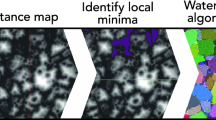Abstract
In the present study, 12 theoretical models have been introduced for studying the effect of the grain size and shape on the intergranular porosity, ∅. From the first eight models, it is stated that the grain size has no effect on the intergranular porosity, but it is declared that the smaller the grain size means the smaller the interstitial pore spaces and therefore, the less the ability of the pore spaces to receive finer sediments, then the higher the porosity. On the other hand, studying the present models revealed that the total intergranular porosity decreases when increasing the grain elongation ‘E’ (the length of the grain/the diameter of the grain) as a shape anisotropy parameter. A new equation has been introduced relating the total pore volume to the grain shape/elongation.
The grain sorting of the present models has been studied by adding another group of grains of the critical grain size of occupation inside the pore spaces; the pore volume decreases by about 41.0 % of the total porosity. To check the applicability of the proposed equation, 46 samples of highly porous sandstone have been selected from different places in Egypt and studied petrographically, and their total pore volume have been measured using Digital Image Analysis (DIA) ‘∅ Im’ and helium injection technique ‘∅ He.’ Petrographically, the studied samples are quartz arenite and ferruginous quartz arenite. The pore types are mostly characterized mostly as (1) intergranular porosity and rarely as (2) intragranular porosity, (3) vuggy porosity, and (4) fracture porosity. The grain elongation ‘E’ for the present samples has been measured using the DIA technique; it varies from 1.34 to 1.73. Porosity ‘∅ He’ varies between 25.8 and 34.7 %, gas permeability ‘k’ varies from 0.14 to 6.92 μm2 (very good to excellent rank), and the mean pore diameter ‘D’ varies between 3.9 and 25.7 μm (macro to mega pores). The study stated the applicability of the present equation and introduced a number of equations that could be used to calculate porosity, permeability, and pore radius in terms of grain elongation. The applicability of the present study has some limitations due to (1) cementation, (2) microporosity, and (3) fracturing. The effect of cementation can be minimized by processing the grains and the surrounding cement statistically as a bulk ellipsoid unit, whereas the micropores/fractures can be measured by helium injection.










Similar content being viewed by others
References
Benson PM (2004) Experimental study of void space, permeability and elastic anisotropy in crustal rock under ambient and hydrostatic pressure, Ph.D. thesis. University of London, London
Benson PM, Meredith PG, Platzman ES, White RE (2005) Pore fabric shape anisotropy in porous sandstone and its relation to elastic and permeability anisotropy under isostatic pressure. Int J Rock Mech 42:890–899
Berryman JG (1985) Measurement of spatial correlation functions using image processing techniques. J Appl Physics 57(7):2374–2384
Choquette PW, Pray LC (1970) Geologic nomenclature and classification of porosity in sedimentary carbonates. Bull Am Ass Petrol Geol 54(2):207–250
Dickson JAD (1966) Carbonate identification and genesis revealed by staining. J Sediment Petrol 36(2):491–505
European Committee for Standardization, CEN, (1992) European Standard Program EN 993–1 (Proposed Draft); Tests for geometrical properties of aggregates, Part 1: Determination of particle size distribution granulometric analysis (sieving Method). CEN Brussels.
Fraser HJ (1935) Experimental study of the porosity and permeability of clastic sediments. J Geology 43:910–1010
Füchtbauer H (1967) Influence of different types of diagenesis on sandstone porosity, Proc. 7th World Petrol. Cong Mexico 2:353–369
Graton LC, Fraser HJ (1935) Systematic packing of spheres, with particular relation to porosity and permeability. J Geology 43:785–909
Jones C, Meredith PG (1998) An experimental study of elastic wave propagation anisotropy and permeability anisotropy in an illitic shale, in Eurock‘98. Rock Mech Petrol Eng 2:307–313
Jones S, Benson P, Meredith P (2006) Pore fabric anisotropy: testing the equivalent pore concept using magnetic measurements on synthetic voids of known geometry. Geophys J Int 66:485–492
Levorsen AI (1967) Geology of Petroleum. W.H. Freeman Company, San Francisco, USA
Lo TW, Coyner KB, Toksoz MN (1986) Experimental determination of elastic anisotropy of Berea sandstone, Chicopee shale, and Chelmsford granite. Geophysics 51:164–171
Louis L, David C, Metz V, Robion P, Menendez B, Kissel C (2005) Microstructural control on the anisotropy of elastic and transport properties in undeformed sandstones. Int J Rock Mech 42:911–923
Mavko G, Mukerji T, Dvorkin J (2009) The rock physics handbook: tools for seismic analysis of porous media, 2nd edn. Cambridge Univ, Press, England
Nabawy BS, Rochette P, Géraud Y (2009) Petrophysical and magnetic pore network anisotropy of some cretaceous sandstone from Tushka Basin, Egypt. Geophys J Int 177(1):43–61
Persson AL (1998) Image analysis of shape and size of fine aggregates. J Eng Geology 50(1–2):177–186
Pettijohn EJ (1984) Sedimentary rocks, 3rd edn. CBS publishers & Distributors, Delhi
Pettijohn FJ, Potter PE, Siever R (1973) Sand and Sandstone. Springer-Verlag, Berlin, p 618
Ragab MA, El Sayed AA, Nabawy BS (2000) In: Soliman SM (ed) Physical parameters of Egyptian oil reservoir sedimentary rocks: a review, in Sedimentary Geology of Egypt: applications and economics. Sedimentological society of Egypt, Cairo, pp 129–150
Rasolofosaon PNJ, Zinszner BE (2002) Comparison between permeability anisotropy and elastic anisotropy of reservoir rocks. Geophysics 67:230–240
Serra O (1984) Fundamentals of well-log interpretation. Elsevier, Amsterdam
Acknowledgments
I would like to thank the reviewers for their great comments that improved and reconstructed the manuscript. I would also like to give thanks to Editor Prof Abdullah M. Al-Amri whose patience and insightful suggestions have led to a new concise revised version.
Author information
Authors and Affiliations
Corresponding author
Rights and permissions
About this article
Cite this article
Nabawy, B.S. Estimating porosity and permeability using Digital Image Analysis (DIA) technique for highly porous sandstones. Arab J Geosci 7, 889–898 (2014). https://doi.org/10.1007/s12517-012-0823-z
Received:
Accepted:
Published:
Issue Date:
DOI: https://doi.org/10.1007/s12517-012-0823-z




